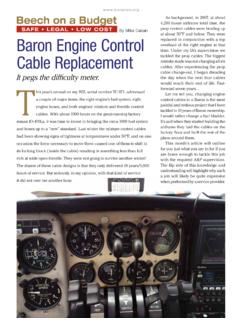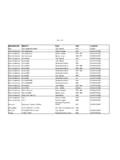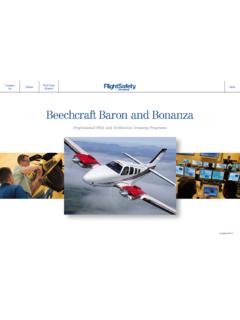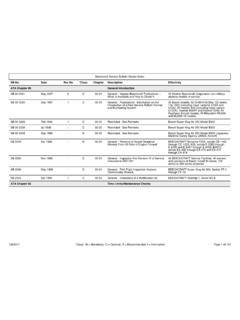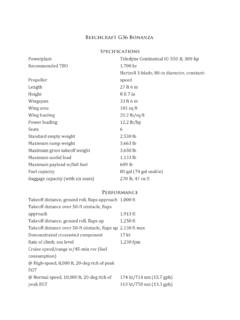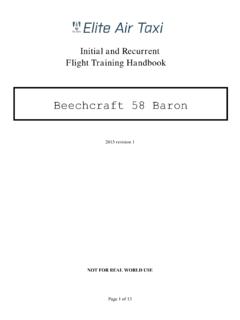Transcription of BONANZA A36 - Laser Design Services
1 BONANZA A36 This .91-powered Beech executive craft is an exquisite example of Precision Scale at its best. A scratch builder's project PAR EXCELLENCE. By Bud Caddell Photos by the author Flight shots by Gary Tatasiore Yep! It's a BONANZA , even though it doesn't have that funny looking V-tail. However, it's a direct descendant of the original that's been in continuous production since 1947, The V-tail was originally a cost and weight saving scheme although it appeals to some, the V-tail is now outsold by straight-tailed Bonanzas at a 3-to-l clip. It wasn't much of a dilemma for me to decide which one to build .. the A36 is a stretched version and better suited for R/C than other BONANZA models.
2 The scale is a 2-5/8 "-to-the-foot. I kept scaling until it was large enough for a Webra .91 to fit comfortably in the cowl, along with a Tatone .91 manifold. The A36 has a nose gear that is as far forward as a nose gear can be. The nose strut also has a forward rake so, even though this is a big model, it did become a little crowded in the cowl area. The nose gear mount is somewhat unconventional, but it has worked out very well. I happened to have some magnesium angle stock from which to fabricate it. I'm sure some tempered aluminum angle would work just as well, I'm not going to give you glue-joint-by-glue joint run down of the construction.
3 We've covered everything pretty well in the plans. However, there are a few high points I'd like to cover. Once the crutch is laid down and the bottom formers are glued in, do as much sheeting as you can before unpinning. Support the side sheeting off the board halfway up the crutch, so that you'll have some balsa to glue to when you start on the top half. The foam used in the cabin area is urethane, and polyester resin doesn't attack it. Cut the cabin outline from the foam, tack-glue between formers F-2A and F-6A. Shape, using the templates furnished in the plans. When to the proper contour, apply three coats of Johnson's paste wax to the foam.
4 Apply two layers of 8 oz. fiberglass Cloth, letting the cloth overlap the balsa about an inch. Feather-edge the cloth into the balsa by applying masking tape over the edges of the wet cloth. When cured, the tape will peel off with no problems. Finish the job with micro balloons and resin. The entire fuselage is then covered with 2 oz. fiberglass cloth. Squeegee as much resin from the cloth as possible. Two or three coats of Super-Poxy primer, sanded between coats with 320 wet or dry paper, will produce a slick surface on which to paint. The wing is of conventional built-up construction. Don't omit the shear webbing between the ribs.
5 This is where much of the strength comes from. Do as much work on the wing as possible before joining the halves, it's a big wing and can be cumbersome to work on. The wing and tail-feathers are finished in the same manner as the fuselage. The overlapped panel lines are two layers of masking tape laid down along the line. Micro balloons and resin are worked against the tape with a spatula forming a fillet about 1/2" wide. When cured, it's sanded down to the tape, and then the tape is removed. The BONANZA is finished with R-M acrylic lacquer. This is a very fine auto lacquer that is very close to the gloss you get with Super-Poxy. The full-size BONANZA has a high-gloss finish, and I wanted the same on mine.
6 The results I usually get with epoxy paints have ranged all the way from great to awful. I'm careful to vacuum the surface and run a tack rag over it but still I occasionally get specks in it. A fellow club member told me about R-M. I tried it on the fuselage of a Pattern bird, and it has held up very well. My tests showed that R-M is not nearly as brittle as other acrylic lacquers. I used very little plasticizer in the paint and still got a film that I could lift off of a piece of masking tape without cracking. The great advantage of Lacquers is that, if you do get a sag or run you can sand it down, then spray thinner (with retarder in it) to restore the gloss.
7 If you're not completely happy with the results you get on the final coat, it's a simple matter to sand it down with 600 wet or dry and then spray thinner and retarder over it. If you're not as lazy as I am, you can enhance the gloss with polishing compound and automotive wax. The A-36 has .010 vacuumed-formed styrene ailerons, flaps, and elevator skins. The surfaces are built in the conventional manner, and then grooves are routed in the sheeting to accept the plastic skins. A word of caution is due here. The same method was used on my baron (June '79 SR/CM) with great results. The baron 's all-white surfaces have set out in the sun at contests for hours on end, with no distortion set out in the sun at contests for hours on end, with no distortion This 2-5/8"-scale model is large enough that its 161/2 pound weight isn't critical.
8 Construction is all-balsa, except for a unique foam/fiberglass structure in the cabin area. scale r/c modeler 57 The author assembles his pride and joy, with help from a few friends. This shot gives a good feel for the size of the BONANZA . to the plastic. However, the color scheme I chose for the A-36 was principally white, with dark blue flaps and ailerons. At an outdoor exhibit, the A-36 was subjected to 90 heat for three hours. There were definite signs that the plastic overlay was being distorted from the heat only in the dark areas. The white was cool to the touch, while the dark blue was definitely hot. Therefore, if your bird is going to be in the hot sun for a while, I would advise going with all-balsa surfaces.
9 I have experimented with a Dremel tool with router attachment, and believe that a very realistic surface can be obtained with this on an all-balsa surface. The A-36 weighs lbs. dry, ready-to-fly. This works out to be a wing loading of about 30 ft. If yours runs heavier, don't fret, because the Wing will probably support 18-19 lbs. without serious damage to the performance designed for 20 lb. airplanes and, if for no other reasons, you should strive to keep the weight down so you won't have to change the nylon bearings every 25-30 flights. The elevators are set up with full up trim on the transmitter giving neutral elevator. You'll probably get level flight with a little down trim.
10 I have found with this force arrangement that you have a smoother transition from power-on/flaps-up, to power-off/flaps-down. This doesn't mean that you won't have to feed down trim in, but it does mean that you won't get a violent pitch up when the flaps are coming down. Full flap deflection is 30 just like full-size. If you haven't flown flaps before, for goodness sake practice some landings at 200 ft. The sink rate with flaps is entirely different. Set the engine up to give 3500 rpm at high idle trim, then drop the gear and flaps at about 300 ft. and fly by at about 200 ft. Note how much back pressure is on the sick. Now just imagine that the runway is at 200 ft.
